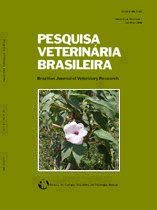 |
|
|
|
Year 2012 - Volume 32, Number 1
|

|
In vitro efficacy of disinfectants used for antisepsis of teats against yeasts isolated from milk of dairy cows with mastitis, 32(1):61-65
|
ABSTRACT.- Coutinho L.C.A., Medeiros E.S., Silveira N.S.S., Silva L.B.G. & Mota R.A. 2012. [In vitro efficacy of disinfectants used for antisepsis of teats against yeasts isolated from milk of dairy cows with mastitis.] Eficácia in vitro de desinfetantes utilizados na anti-sepsia dos tetos frente a leveduras isoladas do leite de vaca com mastite. Pesquisa Veterinária Brasileira 32(1):61-65. Departamento de Medicina Veterinária, Universidade Federal Rural de Pernambuco, Av. Dom Manuel de Medeiros s/n, Dois Irmãos, Recife, PE 52171-900, Brazil. E-mail: rinaldo.mota@hotmail.com
The aim of this study was to evaluate in vitro sensibility of yeast isolated from milk of dairy cows with mastitis against some commercial disinfectants used in pre and post-dipping in dairy farms of the State of Pernambuco. After identification, 12 yeast isolates were tested with the following disinfectants: iodine at 0,57%, chlorine at 2,5%, chlorhexidine, lactic acid and quaternary ammonium at 2,0%, at different exposure times. It was observed that 100% of the isolates were sensitive to chlorhexidine at all exposure times. Iodine has obtained the second best result with the following percentages: 83,33% were susceptible at 15’’ exposure, 91,7% in 30’’ and 100% were sensitive at 60’’ 300’’ and 600’’ times. For lactic acid, the results were 41,67% sensitive at 15’’ of exposure, 58,33% at 30’’, 66,7% at 60’’ and 300’’ and 75% at 600’’. In the analysis of the results for quaternary ammonium, it was observed that 66,67% were sensitive in 15’’and 30’’ times and 91,67% at 60’’, 300’’ and 600’’. Regarding the chlorine activity, only 16,67% were sensitive at the 15’’ and 30’’ times, and 25% at 60’’, 300’’ and 600’’. It was concluded that chlorhexidine and iodine have disinfectant activity significantly superior to chlorine, against to yeast involved in infectious processes of the mammary gland in cattle. It is necessary to perform a periodic assessment of the disinfectant activity from products used in the pre and post-dipping routine against dairy farms microorganisms most commonly involved in cases of mastitis (bacterial or fungal) which is an effective alternative to reduce the frequency of mastitis in cattle. |
| |
|
|
| |
|
 |